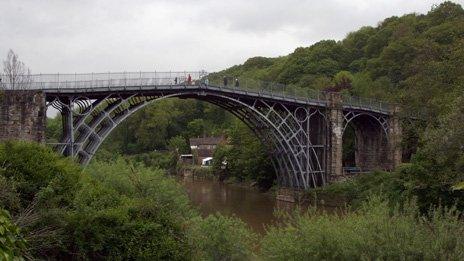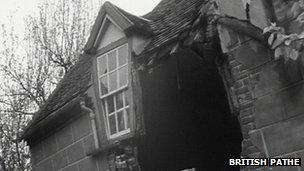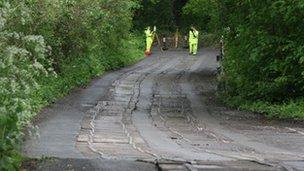Ironbridge Gorge: Securing future for World Heritage Site
- Published

Abraham Darby III's iron bridge, built in 1779, was the world's first iron structure and became an immediate hit with 18th Century tourists
While world heritage sites can bring in millions of pounds in tourism, Ironbridge Gorge shows they don't always come cheap.
Dubbed the birthplace of the industrial revolution, in 1986 the site was one of the first in the UK to be designated with the special status by Unesco, joining the likes of the pyramids of Giza and the Taj Mahal.
But while the famous iron bridge looks immovable, for centuries the gorge has been a fragile landscape, suffering from countless landslides, floods and even collapsed houses and roads.
Engineers estimate protecting the gorge even for the immediate future could cost more than £80m, although few doubt it is worth safeguarding.

A landslide in 1952 caused houses to collapse in Jackfield
Telford and Wrekin Council said it had a commitment to protect the area, while Ironbridge Gorge Museums Trust said it was important to remember it was not simply "a theme park", but "people's homes".
"You can assess the likelihood [of a landslide], depending on rainfall and other triggers, but you can never say 'We're going to expect one tomorrow, or in a week or in a year'," Neal Rushton, from the local authority, said.
The "significant challenge" of monitoring, countering and repairing ground movement falls to Mr Rushton and his team.
"We've got 300 years of records, but landslides have been happening in the gorge for 10,000 years, so it feels like we're still doing a bit of crystal ball gazing," he said.
Evacuation centres
The unpredictable nature of the area means the local authority is also preparing for a major emergency, even though it said more gradual ground movements were far more likely.
Evacuation centres have been identified and the council has just released a pamphlet warning residents of the dangers.
The authority said "major events" in the gorge typically happened every 30 to 50 years, with the most recent occurring in the 1980s.
At that time houses collapsed in Jackfield and Salthouse Road fell into the river.
A flexible wooden road, laid in the wake of the 1980s disaster, is set to be removed as part of the latest stabilisation work, due to start in earnest next year.
Metal piles will be driven into the ground to anchor it in place and the banks of the River Severn will be reinforced to prevent erosion.
By the time the latest work is completed in 2016, some £33m will have been spent on shoring up the gorge since 2001.
According to former chairman of English Heritage Sir Neil Cossons, far more will be needed in the coming years.
One of the team who put together the original bid for Unesco, Sir Neil said the site "absolutely deserved" to be protected, not just for Telford, but the nation as a whole.
The very activity that earned Ironbridge its place among the world's most important heritage sites has, however, also contributed to its problems.
Mr Rushton said his teams "routinely" came across old mine workings, further complicating their work.
'Guerrilla mining'
According to the Ironbridge Gorge Museums, the number of historic coal mines was "almost impossible" to count.
Senior curator Matt Thompson said there was practically "guerrilla mining" in the gorge during the 18th Century.
"Two or three blokes would work a seam on some land they had permission on. They'd dig a hole and work it for as long as they could," he said.
The mines grew up around the blast furnaces and iron casting sites that set Britain on the road to becoming the world's first industrial power.

A flexible wooden road was laid in Jackfield after a landslip in the 1980s
Mr Thompson said the string of furnaces attracted 18th Century tourists and even artists keen to paint the scene - who consistently described it as "like the underworld, like Hades or Hell".
Today, Ironbridge attracts more than 750,000 visitors a year, attracted by the beauty of the area, but unlike monuments such as Stonehenge, it is also home to thousands of people.
Helping to protect them is a network of more than 100 underground sensors, monitoring land movement.
An unexpected landslide on Jiggers Bank in November, however, showed the limits of technology.
An extra responsibility for those protecting the gorge, Mr Rushton said local people could also prove to be a valuable resource.
He said the 550 hectare site (1,360 acres) was "a huge piece of land to keep an eye on" and residents' reports of changes in embankments or cracks in paths could provide an early warning system.
- Published25 March 2013
- Published21 March 2013
- Published26 November 2011
- Published29 November 2012
- Published25 January 2013
- Published4 October 2012